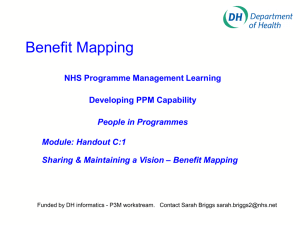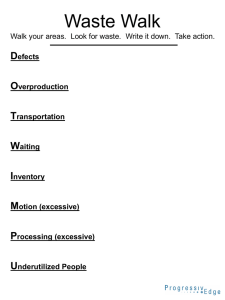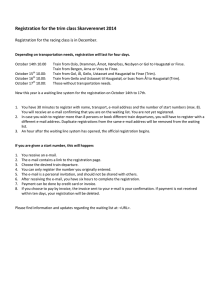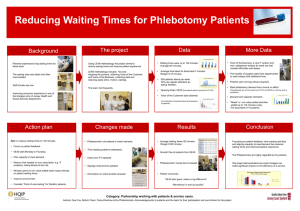CANCER WAITING TARGETS – A GUIDE FOR
advertisement
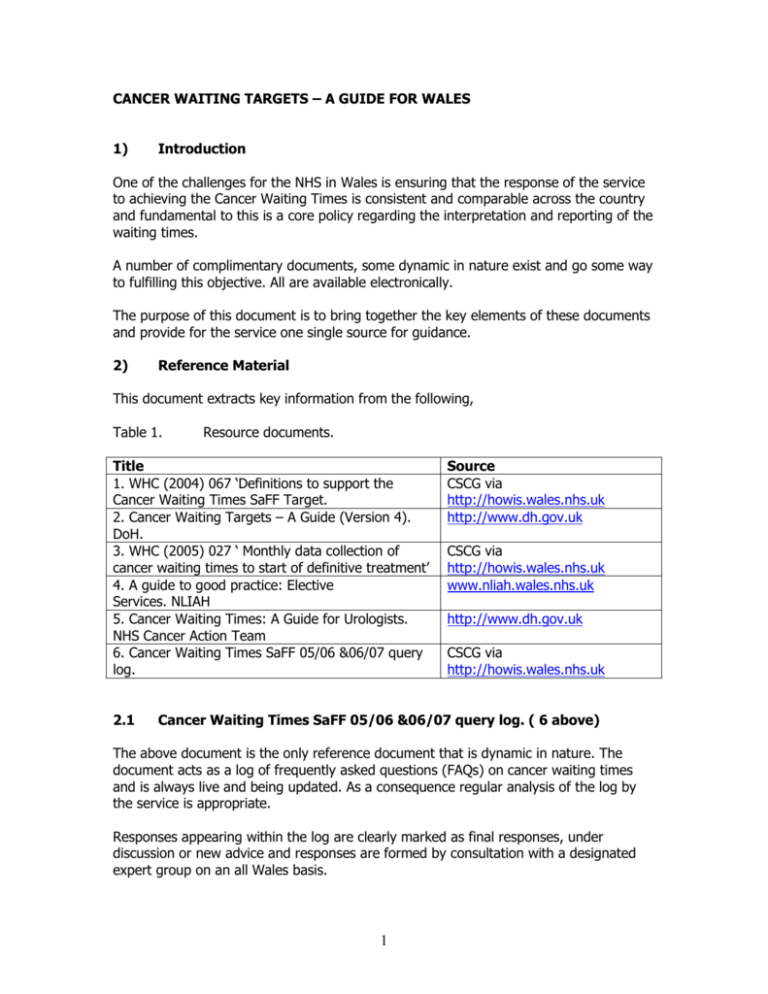
CANCER WAITING TARGETS – A GUIDE FOR WALES 1) Introduction One of the challenges for the NHS in Wales is ensuring that the response of the service to achieving the Cancer Waiting Times is consistent and comparable across the country and fundamental to this is a core policy regarding the interpretation and reporting of the waiting times. A number of complimentary documents, some dynamic in nature exist and go some way to fulfilling this objective. All are available electronically. The purpose of this document is to bring together the key elements of these documents and provide for the service one single source for guidance. 2) Reference Material This document extracts key information from the following, Table 1. Resource documents. Title 1. WHC (2004) 067 ‘Definitions to support the Cancer Waiting Times SaFF Target. 2. Cancer Waiting Targets – A Guide (Version 4). DoH. 3. WHC (2005) 027 ‘ Monthly data collection of cancer waiting times to start of definitive treatment’ 4. A guide to good practice: Elective Services. NLIAH 5. Cancer Waiting Times: A Guide for Urologists. NHS Cancer Action Team 6. Cancer Waiting Times SaFF 05/06 &06/07 query log. 2.1 Source CSCG via http://howis.wales.nhs.uk http://www.dh.gov.uk CSCG via http://howis.wales.nhs.uk www.nliah.wales.nhs.uk http://www.dh.gov.uk CSCG via http://howis.wales.nhs.uk Cancer Waiting Times SaFF 05/06 &06/07 query log. ( 6 above) The above document is the only reference document that is dynamic in nature. The document acts as a log of frequently asked questions (FAQs) on cancer waiting times and is always live and being updated. As a consequence regular analysis of the log by the service is appropriate. Responses appearing within the log are clearly marked as final responses, under discussion or new advice and responses are formed by consultation with a designated expert group on an all Wales basis. 1 Within this document FAQs resolved as a part of this process are included or referred to within the general text. 3.) The Cancer Waiting Time targets in Wales The Cancer Targets feature in WHC (2005) 027 ‘ Monthly data collection of cancer waiting times to start of definitive treatment’ and are for full compliance as part of SaFF 2006/07. The cancer waiting times target for Wales are as follows: a) Newly diagnosed cancer patients that have been referred as USC and confirmed as urgent by the specialist to start definitive treatment within 2 months (62 days) from receipt of referral at the hospital. b) Newly diagnosed cancer patients not included as USC referrals to start definitive treatment within 1 month (31 days) of a decision to treat. The targets should be complied with in full by December 31st 2006. 3.1) Defining the statements within the targets. Newly diagnosed cancer patients that have been referred as USC and confirmed as urgent by the specialist to start definitive treatment within 2 months (62 days) from receipt of referral at the hospital. referred as a USC - a suspicion of cancer is stated by the GP and confirmed by the specialist referred as a USC - not restricted to designated USC only referral methods e.g. fax lines referred as a USC – will include non USC GP referrals upgraded to USC by the specialist when he/she has viewed the referral information receipt of referral by the hospital – if confirmed as USC by the specialist the 62 days commences from when the hospital received the referral not when the specialist saw the referral. first definitive treatment – any initial treatment that treats the patients cancer, stabilizes their symptoms from cancer, stabilizes their health so cancer treatment can commence – ( see Appendix 1 for further detail) Newly diagnosed cancer patients not included as USC referrals to start definitive treatment within 1 month (31 days) of a decision to treat. not included as USC referrals – any patient who was not referred by their GP as a USC or not referred by their GP and upgraded by the specialist on analysis of the GP referral 2 decision to treat – the point in time when a clear range of treatment options is offered to the patient by an MDT member and the patient elects for a given option – (see Appendix 2 for further detail). The last stage above also has an application within the pathway of the 62 day target. 4.) Who reports the waiting time information? In Wales the Trust that reports the wait to the appropriate organization (see later) is the organization that, receives the initial USC referral identified as such by the GP and confirmed by the specialist receives an initial GP referral that is upgraded to a USC by the specialist diagnoses a cancer in a non USC referral Powys LHB do not report any Cancer Target information on the basis that the only cancer patients diagnosed and treated within Powys alone, will be done so by the GP and as such will not be applicable within the terms of the SaFF. 4.1) The responsibility of tertiary organizations Despite the comment above tertiary providers of first definitive treatment must organize their services in a manner that ensures that the patient receives their first definitive treatment within the established timescales. This implies that not only do tertiary organizations need to ensure efficient provision of care but the referring (and reporting) organization must do all it can to ensure that the clinical pathway up to the point of referral to the tertiary organization has been as efficient as possible. Though reporting in Wales is identified as being with one organization achievement of the target is shared between organizations and this should be demonstrated through the organizations working together to deliver the target and resolve breaches where more than one organization is implicated. Breast Test Wales (BTW) and screen detected cancers Breast Test Wales will collect the 'decision to treat date' for screen-detected breast cancers in the 'Date Results Given' field on the NBSS system against the appropriate diagnostic test. This can then be made available electronically with the NHS Number to the treating Trust for matching against first treatment date. Trusts will need to ensure that they approach screening services for a suitable file of information on a quarterly basis. Dr Diane Brook, Head of Information, Screening Services on (029) 20787815 or WHTN: 1896 7815 can be contacted in the first instance. 3 5.) When information is collected when and where is it sent? 5.1 Two information processes should be followed. a) The cancer PTL (Primary Target Lists) was introduced in consultation with the Regional Offices, Cancer Networks and Informing Health Care cancer team in August 2006. Its aims are to facilitate real time prospective monitoring against the cancer targets for all patients that have been referred as either Urgent Suspected Cancer (62 day target) or Non Urgent Suspected Cancer (31 day target). Weekly PTLs should be submitted to Regional Offices and the Delivery Support Unit Andrew.Sallows@dsu.wales.nhs.uk every Wednesday by 5pm using the agreed pro-forma. b) Monthly cancer waiting times data will be returned to the Health Statistics and Analysis Unit (HSA) in accordance with the timetable issued in WHC (2005) 027- see Appendix 3. 5.2 Breach reporting 5.3 It is a requirement from 1 January 2007 that all ‘Reporting Trusts’ report all breaches of the 31 and 62-day targets to the Regional Cancer Network and Regional Office. Breach reports must be provided where performance for all cancer patients is less than 100% for both the 31 and 62 day targets. This includes those patients that have breached for reasons of clinical exception. 5.4 There will be some cases where the achievement of this target is not appropriate for clinical reasons. For example, there will be a small number of patients whose clinical pathway is complex and, the diagnosis element of the pathway is understandably difficult, or not clinically appropriate. This has necessitated the introduction of tolerance levels. 5.5 The introduction of tolerance levels, which allow for exceptions on the grounds of clinical appropriateness, will assist in ensuring that an accurate picture of performance against the target is available. 5.6 The tolerance levels will be applied from 1 January at an aggregate level for all cancer sites e.g. the tolerance will be applied to the total sum of patients across all sites on a monthly basis. The levels are illustrated below: 62 day target – a tolerance level of 95% 31 day target – a tolerance level of 98% 5.7 It is important to note that the introduction of these tolerance levels does not reduce the target of 100% in any way, but recognises that there may be clinical reasons why this level of performance cannot be achieved. 4 5.8 It will be essential that the pathway avoids all unnecessary delays thus ensuring clinical appropriateness is the only reason for patients waiting longer than the 62 or 31 days respectively. 5.9 All Trusts reporting breaches must be do so using the using the attached template (CBR01). 5.91 All breach reports must be submitted to the appropriate Regional Offices and the Regional Cancer Networks, no later than the last working day of the month. The breach reports should include data relating to the previous month e.g. reports submitted on the 28th February 2007 should include breaches that occurred between January 1st and 31st. 5.92 The Welsh Assembly Government will take both the clinical exceptions and tolerance levels into account when monitoring and evaluating performance against these targets. 5.93 The provision of breach reports in cases of clinical exception will be reviewed as the quality of data and reporting improves within Wales. 5.94 The use of the paper based breach reporting system is an interim arrangement. It will be replaced by reports provided by CaNISC following full implementation across Wales. 6.) What the Health Stats information submitted should represent. As a general principle the information presented should provide only information about 7.) the the the the number of referrals received suspecting cancer numbers of patients diagnosed with cancer numbers waiting to receive definitive treatment numbers having received definitive treatment Information parameters – when to stop and re-start the clock. A more comprehensive explanation of the definitions surrounding waiting list management is included in section 2 of NLIAH’s Guide to Good Practice. The details below are a summary of this. 7.1) Classification of DNAs and CNAs a) Did Not Attend (DNA) A Did Not Attend (DNA) is recorded where a patient does not attend any appointment or admission within the Trust without notifying the Trust. 5 Treatment of DNAs Any patient who fails to attend their appointment or admission should be removed from the appropriate waiting list and, if this is the first outpatient appointment the clock restarted from the date of the request for reinstatement. The adjustment is the number of days from date receipt of referral at the Trust to date of reinstatement. (i.e. clock is reset) Following the patient's DNA the Trust should communicate with the patient's GP to determine how a new appointment can be arranged. b) Could Not Attend (CNA) A Could Not Attend (CNA) is recorded where a patient notifies the Trust that they will not be able to attend an appointment or admission event, up to the end of the day of their appointment or admission. Treatment of CNAs First CNA Any patient who contacts the Trust to notify it that they will be unable to attend an outpatient appointment or admission event should have another appointment or event arranged at the time of notification. If this is the first outpatient appointment the clock restarts from the date of the contact with the patient, in most cases this will be the date of the appointment the patient could not attend. The adjustment is the number of days from date of receipt of referral in the Trust to the date of contact with the patient. (i.e. clock is reset) CNA – for admission The patient is offered a reasonable date for admission but the patient cannot attend. Provided the admission date was a reasonable one (i.e. there was a sufficient amount of notice and the provider took account of personal circumstances) this is described as a self-deferral. In such a case the waiting time is adjusted by the number of days from date of decision to treat to the date the admission was scheduled to take place. Example A patient is contacted by the trust and offered an admission date for surgery to treat their breast cancer. They later declare that they are unable to attend on this date as they have another commitment on that day. In this case the period between the admission date they declined and the decision to treat date is to be removed by an adjustment. Note: if the provider cancels the admission then there is no affect on the waiting time. 6 (e.g. the 31 day target waiting times is calculated from the original decision to treat date) Second CNA When a patient contacts the Trust to cancel a second appointment the Trust may treat the cancellation as a DNA and not make an appointment. In this case, the communication standards for a DNA must be followed. Reinstatement to the waiting list Reinstatement to the waiting list can be made by a reasonable request from the patient, or by an authorised Trust employee or the patient’s GP or GDP. The patient will be reinstated on the waiting list with their Waiting List Date (WLD) set to the date of the request for reinstatement. A reasonable request from the patient for reinstatement could be either clinical (because a condition has recurred or got worse since removal) or social (the patient may have been away from home when the validation letter or partial booking letter was received, and will ask for reinstatement on their return). In all cases the patient will be returned to the waiting list with their Waiting List Date (WLD) set to the date of the request for reinstatement, for the section of the pathway from where they were removed. For example, if they were removed from the list waiting list for admission for treatment, they will be reinstated at that point rather than waiting again for outpatient admission. 7.2) Deferments Deferment is where a patient has not complied with instructions. In some cases surgery or investigative procedures require that the patient undergo a period of preparation at home prior to admission or attendance. One example would be the requirement to fast before surgery; another would be bowel preparation before colonoscopy or barium enema. Sometimes patients attend their admission or appointment without having completed the required preparation, and the procedure cannot be undertaken. In these cases the patient should be treated as a CNA. The WLD will be reset to the current date as part of the CNA process, and multiple non compliance would also fall within the CNA process. 7.3) Suspension for social reasons A patient may be suspended from the waiting list when, due to either medical or social reasons, the patient is unable to move on to the next stage of the pathway. The clock stops when 7 When a patient has other commitments they wish to pursue prior to treatment or investigation (e.g. Holiday) When a patient requests a period of time to think (e.g. to decide on treatment options) When a patient requests a second opinion before making a decision on treatment. (The clock does not stop if the clinician requires a second opinion) Suspensions must be clearly recorded in the patient notes. The position of any patient suspended must be reviewed regularly. The clock does not stop When a patient chooses a treatment with a longer waiting time (e.g. radiotherapy rather than surgery) A patient should not be suspended once an admission date has been agreed, unless the date is later than normal due to the need to resolve other medical problems prior to treatment. Examples of social suspensions A patient with cancer is seen by the oncologist and is suitable for a clinical trial. The patient is given the details and told he/she needs to make a choice about whether or not they wish to take part in the trial. This two-step process is good practice in terms of informed consent. Whilst taking the time to make the decision, the patient will be classed as suspended for patient reasons as he/she is technically unavailable for treatment. The clock starts again as soon as the patient has told the oncologist of their decision. Note: Allowing patients time to consider treatment options is part of good clinical practice and is not confined to clinical trials. A young patient is advised that potentially curative treatment involves significant risk of serious side effects (which may include peri-operative death). The patient wishes to be referred for a second opinion to see if they might avoid these outcomes but yet still achieve cure. The patient is suspended for patient reasons as they have made themselves unavailable for treatment whilst seeking a second opinion. A patient is discussing their care-plan with a clinician and states (before any offer of an admission date is made) that they would like to take the holiday they have booked prior to treatment starting. As no offer of a TCI date had been made by the trust this can be classified as a suspension for patient reasons. The period which the patient has made themselves unavailable should be adjusted out of the calculated waiting time. 7.4) Suspension for medical reasons The clock stops when 8 When a patient is unavailable for admission for a period of time due to another medical condition that needs to be resolved When a patient is unavailable for a diagnostic or staging test or treatment due to another medical condition that needs to be resolved (e.g. reduce weight) Suspensions must be clearly recorded in the patient notes. The position of any patient suspended must be reviewed regularly. The clock does not stop When the trust is unable to offer treatment within the required timescales. For a patient who requires repeat biopsies or scans because of uncertainty the first time round. In patients for whom there is genuine clinical uncertainty about the diagnosis and the clinician elects to observe the patient over (say) a three month period. A patient should not be suspended once an admission date has been agreed, unless the date is later than normal due to the need to resolve other medical problems prior to treatment Examples of suspension for medical reasons Some cancer patients will have co-morbidities, which will require investigation and/or treatment prior to administering cancer treatment. For example a cancer patient with angina may be referred for a cardiology opinion prior to treatment. In this case the clock will only stop if the cardiology opinion is that the patient is medically unfit for cancer treatment. If the opinion is that the patient is fit for cancer treatment then the clock does not stop. Hence the clock does not stop whilst an opinion on the co-morbidity is being sought. A similar example would be where a patient with mouth cancer requires dental extraction prior to commencement of radiotherapy treatment – the clock would stop while the patient was not fit for treatment following the extraction, but not whilst they were waiting for the extraction. Patients with severe frailty/cachexia related to the cancer. A patient who requires intensive nutritional support (e.g. through intravenous feeding or through nasogastric feeding) before they are fit for surgery. The clock stops for the period the patient is medically unfit for surgery, with the start date of this period of suspension being defined as the date when a medical opinion as to their being unfit for treatment was received. A patient with cancer also has COPD. He/she is technically suitable for surgical resection but considered in need of a medical opinion (in this case usually a respiratory physician). The respiratory physician confirms the patient is medically unfit for the surgery at that time (clock stops at this point) (see above) and wishes to institute a changed therapeutic regime to optimise their respiratory function before surgery. The patient is suspended until medically fit for the surgery. In prostate cancer following a transrectal ultrasound-guided biopsy there may be 9 swelling of the prostate gland. This makes interpretation of MRI scans unreliable. Many clinicians would advocate that there should be a planned interval of up to 4 weeks between biopsy and MRI, as the gland swelling means the patient is medically unfit for the scan and so a medical suspension is appropriate. 8) Information parameters – what and what not to include 8.1) Generic definitions regarding information content. All patients under 16 years of age at date of first definitive treatment should be grouped as Children’s Cancer. For Kaposi’s sarcoma – a new cancer care episode should be started for each Kaposi sarcoma diagnosed. In the case where a patient is initially seen by the specialist privately but is then referred for first definitive treatment under the NHS, the patient should be included under the 31 day decision to treat target. The targets only apply to patients with a newly diagnosed cancer. Some patients have metastases at presentation and so the treatment may be to the metastatic site rather than the primary site. When a patient is diagnosed with a second new cancer, which is not a recurrence, then the targets will apply to the treatment of this cancer. A purely diagnostic procedure (including biopsies) does not count as treatment unless the tumour is effectively removed by the procedure, examples of this would be a polypectomy during a Colonoscopy or an excision biopsy of a melanoma. If an excision biopsy is therapeutic in intent (i.e. the intention is to remove the tumour) then clearly this will count as first treatment, irrespective of whether the margins were clear. When a patient is referred on suspicion of one cancer but is diagnosed with another within the same care spell that is of greater clinical priority, that care spell should be monitored under the 62-day target from urgent referral to treatment. A patient who is diagnosed incidentally for cancer should be monitored under the 31 day decision to treat target. 8.2) Generic reasons for exclusion Death whilst on the waiting list 10 A recurrence of the original primary cancer at a secondary site Treatment for a recurrence of cancer. Patients who decline any treatment (including palliative care) All in situ disease (with the exception of Ductal Carcinoma in situ (DCIS)) Patients who are diagnosed on the NHS but treated privately In a small number of cases there will be good clinical reasons for treatment time exceeding the target time. A generic example of this is where a patient is referred under the two week wait and there is diagnostic uncertainty as to whether they have cancer or not. These patients may require repeat diagnostic tests in order to reach a diagnosis. A patient who requires a particularly complex combination of scans and biopsies A patient for whom there is genuine clinical uncertainty about the diagnosis and the clinician elects to observe the patient over (say) a three-month period. These patients will exceed the 62 day wait and the detailed reasons why these patients exceeded the target time should be recorded in the breach analysis. 8.3) Disease specific inclusions/exclusions. Disease Group Lung Information “Open and close” lung surgery should still be counted as it is a treatment procedure, although the outcome is unsuccessful. In a patient who is not planned to have active anticancer treatment (e.g. chemotherapy) drainage of a pleural effusion should count - as a palliative care treatment. In other circumstances it will not count. Breast Urology In lung cancer mediastinoscopy would not count as start of treatment When a patient has immediate reconstruction as part of the first definitive treatment this should be within a month of decision to treat where this can possibly be achieved. However if a patient is offered alternative definitive treatment within a month, i.e. Mastectomy without immediate reconstruction, but instead chooses to have the immediate reconstruction at a somewhat later date, the provider should not be penalised for this. Full details on these patients should be provided by the trust in the exception report. When carrying out a TURBT when the intention is to eradicate or substantially debulk the tumour it can be considered first definitive treatment. TURBT remains the first definitive treatment even for patients who require further treatment such as cystectomy or radiotherapy. 11 Upper GI Haematology TURP is not considered a treatment for prostate cancer. Where a patient is given no anti-cancer treatment following a TURP, but they are being actively monitored, the active monitoring should be recorded as first treatment. Insertion of a pancreatic stent counts as start of treatment in the treatment of pancreatic cancer if this intervention forms part of the planned treatment package Cutaneous lymphomas – a new cancer care episode should be started for each cutaneous lymphoma diagnosed. If a patient is not planned to have active anticancer treatment (e.g. chemotherapy or radiotherapy) then a blood transfusion should count - as a palliative care treatment (e.g. for chronic lymphocyte leukaemia). In all other circumstances the blood transfusion would not count as first treatment. Anti-biotics would count as start of treatment for low grade gastric lymphoma. Mycosis fungoides is categorized as a cutaneous T – cell lymphoma and should be reported under haematological cancers. Skin Insertion of Hickman line or any equivalent is not counted as a first definitive treatment For Squamous Cell Carcinoma – most patients have a single lesion at presentation but a significant number will get more primaries over a period of time. Only one cancer care episode (i.e. one record) should be recorded for all these Squamous Cell Carcinomas. Malignant melanoma – a new cancer care episode should be started for each Malignant Melanoma diagnosed. Lentigo Maligna Melanoma should be reported Lentigo Maligna should not be reported. Gynaecology A cone biopsy should count as first treatment in early cervical cancer as it is a curative / definitive treatment for stage 1a disease. A diagnostic loop biopsy in more advanced cases would not usually be called a "cone" biopsy. Date of first hormonal therapy where this is used as primary treatment (eg endometrial cancer in frail patients or very young patients with low grade disease) is first treatment. Date of “treatment enabling” intervention forming part of the planned “treatment package” (eg ureteric stenting for advanced cervical cancer) 12 Head &Neck Palliative care Brain/CNS Dental clearance count as start of treatment in oral cancer would not count as start of treatment. An adjustment to the waiting time can be made if the dental clearance means the patient is unfit for radiotherapy and so the radiotherapy treatment is delayed. Head & neck patients often require the insertion of a PEG (Percutaneous Endoscopic Gastrostomy) prior to surgery or radiotherapy. This procedure enables patients nutrition prior to the start of active treatment. In this case the period they are unfit for the treatment should be an adjustment, but the insertion of the PEG is not the treatment itself. No specific inclusions/exclusions Dexamethasone will only count if the patient is only being cared for palliatively and no other anti-cancer treatment is offered. 13 Appendix 1. – Identifying Definitive Treatment When is the start of definitive treatment? The first definitive treatment should be agreed with the clinician responsible for the patient's management plan. This will be a clinical judgement. First definitive treatment date: The treatment date may be any of the following, “first treatment” refers to the first definitive treatment and may not necessarily be the first planned treatment decided upon by the MDT. If a patient is admitted as an emergency and undergoes immediate surgery, this could be classed as the first definitive treatment, with cancer confirmed on the histology as a result of this surgery. In this case the Date of First Treatment would be earlier than the diagnosis. This will result in a negative waiting time which is always shown as zero. If the first definitive treatment is surgery: Record the date on which the first procedure took place, whether done on an inpatient or day case basis. If the first definitive treatment is chemotherapy and/or anti-cancer treatment (including hormone/endocrine/immunotherapy) Record the date on which the first dose of the drug is administered to the patient. If the first definitive treatment is radiotherapy: Record the date on which the first fraction of radiotherapy for this prescription is administered to the patient. If the first treatment /support is specialist palliative care: Record the date of the first treatment/support from specialist palliative care. If the first treatment is active monitoring: Record the date of the consultation on which this plan of care was agreed with the patient. Examples of first definitive treatment It may be useful to consider the various types of primary “treatment package” that different patients may receive: Many patients will receive a single treatment modality aimed at removing or eradicating the cancer completely or at reducing tumour bulk (e.g. surgery, radiotherapy or chemotherapy). In these cases the definition of “first definitive treatment” and the start date are usually straightforward. A second group of patients will receive a combination of treatments as their primary “treatment package” (e.g. surgery followed by radiotherapy followed by 14 chemotherapy). In these cases the “first definitive treatment” is the first of these modalities to be delivered, and the date is the start date of this first treatment. A third group of patients require an intervention which does not itself affect the cancer to be undertaken prior to the delivery of the anticancer treatment(s) – to enable these treatments to be given safely. Such interventions might include formation of a colostomy for an obstructed bowel or insertion of an oesophageal stent. As these interventions form part of the planned “treatment package” for the patient it has been agreed that the start date of the enabling intervention should be taken as the date of first definitive treatment. A fourth group of patients undergo a clearly defined palliative intervention (e.g. a colostomy or a stent) but do not then receive any specific anticancer therapy. For these patients the start date of this intervention should be recorded as the date of first treatment. A fifth group of patients do not receive any anticancer treatments but are referred specifically to a specialist palliative care (SPC) team. For these patients the date of the first assessment by a member of the SPC team is to be taken as the date of the first “treatment”. A sixth group will receive both anticancer treatment (e.g. radiotherapy) and a specialist palliative care assessment. In this instance the date of the anticancer treatment is to be taken as date of first treatment. Finally, some patients do not receive any specific anticancer treatment/intervention and are not referred to a SPC team. Where the patient is receiving symptomatic support and is being monitored these patients should be classified as undergoing “Active Monitoring”. It is recognised that this is somewhat unsatisfactory as this group encompasses patients with early cancer (e.g. localised prostate cancer where serial monitoring of PSA is undertaken) and those with advanced cancers for which no immediate specific interventions are considered to be warranted. These patients may, of course, require general palliative care including symptom control – given under the care of GPs and/or oncologists. The first definitive treatment is normally the first intervention which is intended to remove or shrink the tumour. Where there is no definitive anti cancer treatment almost all patients will be offered a palliative intervention (e.g. stenting) or palliative care (e.g. symptom control), which should be recorded for these purposes 15 Appendix 2. Date of decision to treat For data collection purposes, the date from which to measure the diagnosis is defined as: The date upon which the decision to treat was confirmed between a designated member of the MDT and the patient Adoption of this definition should eliminate the many variables around defining what is a diagnosis. It is recommended that as part of the MDT discussion around a proposed treatment plan a date is identified at which consultation with the patient can take place, confirming the treatment plan. The date of consultation should be recorded as the decision to treat date. If the first treatment is to be surgery: This is the date that the consultation between the patient and the clinician took place and a treatment plan for surgery was agreed. If the first treatment is to be chemotherapy or other drug treatment: This is the date that the consultation between the patient and the clinician took place and a treatment plan for chemotherapy was agreed. If the first treatment is radiotherapy: This is the date that the consultation between the patient and the clinician took place and a treatment plan for radiotherapy was agreed. If a decision is taken to provide specialist palliative care: This is the date that the consultation between the patient and the clinician took place and a treatment plan for palliative care was agreed, or an agreement to notify palliative care was made. If the first definitive treatment is active monitoring: Record the date on which it was agreed that this patient should be actively monitored. Scenario 1: A patient is discussed at the MDT, and agreement is reached to make an appointment for the patient to attend an outpatient clinic, to receive the diagnosis and discuss the treatment plan. In this scenario, the date of decision to treat would be the planned date of the outpatients appointment. 16 Scenario 2: A patient [not referred as an urgent suspected cancer] is referred to a non-cancer specialist [not a member of the MDT] who diagnoses cancer, discusses the treatment options with the patient and they agree to refer the patient on to the relevant cancer specialist (e.g. Surgeon, Oncologist) In this scenario, the date of decision to treat would be the date at which the relevant cancer specialist sees the patient and agrees the treatment plan. 17 Appendix 3. Data submission Timetable for the monthly collection of cancer waiting times Each NHS Trust will provide 2 monitoring forms (relating to 1a) and 1b) in the summary, WHC (2005) 027) relating to the previous month to the National Assembly for Wales no later than the last working day of the month. Manner of submission of data Data must be submitted using the specifications given below and the forms in Annex C and D to the Health Statistics and Analysis Unit (HSA) of the National Assembly for Wales and the local Regional office. The files should be submitted to HSA by e-mail to: stats.health@wales.gsi.gov.uk The contact address is as follows: Claudia Blair Health Statistics and Analysis Unit Tel: (029) 2080 1268 e-mail: Claudia.Blair@wales.gsi.gov.uk File naming convention The files submitted should be named using the following format: Uxxxmmyy.xls for urgent suspected cancer Nxxxmmyy.xls for ‘non’ urgent suspected cancer where xxx = the Trust code (see Annex E) mm = the number of the month to which the data relates to e.g. 06 for the submission of data relating to cancer waiting times in June. yy = last 2 digits of the year 18




